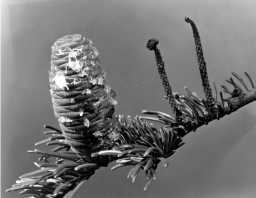|
Do you see...?
|
| Needles
|
Breaking needle buds
One or more breaking needle buds are visible on the plant. A needle bud is considered "breaking" once a green needle tip is visible at the end of the bud, but before the first needle from the bud has unfolded and spread away at an angle from the developing stem.
More...
How many buds are breaking?
- Less than 3
- 3 to 10
- 11 to 100
- 101 to 1,000
- 1,001 to 10,000
- More than 10,000
|
|
|
Young needles
One or more young, unfolded needles are visible on the plant. A needle is considered "young" and "unfolded" once it has spread away from the developing stem enough that its point of attachment to the stem is visible, but before it has reached full size or turned the darker green color or tougher texture of mature needles on the plant.
How many young needles are present?
- Less than 3
- 3 to 10
- 11 to 100
- 101 to 1,000
- 1,001 to 10,000
- More than 10,000
|
| Pollen cones
|
Pollen cones
One or more fresh, male pollen cones (strobili) are visible on the plant. Cones have overlapping scales that are initially tightly closed, then spread apart to open the cone and release pollen. Include cones that are unopened or open, but do not include wilted or dried cones that have already released all of their pollen.
More...
How many fresh pollen cones are present?
- Less than 3
- 3 to 10
- 11 to 100
- 101 to 1,000
- 1,001 to 10,000
- More than 10,000
|
|
|
Open pollen cones
One or more open, fresh, male pollen cones (strobili) are visible on the plant. Cones are considered "open" when the scales have spread apart to release pollen. Do not include wilted or dried cones that have already released all of their pollen.
What percentage of all fresh pollen cones (unopened plus open) on the plant are open?
- Less than 5%
- 5-24%
- 25-49%
- 50-74%
- 75-94%
- 95% or more
|
|
|
Pollen release
One or more male cones (strobili) on the plant release visible pollen grains when gently shaken or blown into your palm or onto a dark surface.
More...
How much pollen is released?
- Little: Only a few grains are released.
- Some: Many grains are released.
- Lots: A layer of pollen covers your palm, or a cloud of pollen can be seen in the air when the wind blows
|
| Seed cones
|
Unripe seed cones
One or more unripe, female seed cones are visible on the plant. For Abies grandis, an unripe seed cone is yellowish-green or occasionally greenish-purple, dark blue, deep purple or gray with scales closed together.
More...
How many seed cones are unripe?
- Less than 3
- 3 to 10
- 11 to 100
- 101 to 1,000
- 1,001 to 10,000
- More than 10,000
|
|
|
Ripe seed cones
One or more ripe, female seed cones are visible on the plant. For Abies grandis, a seed cone is considered ripe when it has turned brown and the scales have begun to separate and fall from the cone, releasing the seeds. Do not include cones that have already dropped all of their seeds.
More...
How many seed cones are ripe?
- Less than 3
- 3 to 10
- 11 to 100
- 101 to 1,000
- 1,001 to 10,000
- More than 10,000
|
|
|
Recent cone or seed drop
One or more seed cones or seeds have dropped or been removed from the plant since your last visit. Do not include empty seed cones that had long ago dropped all of their seeds but remained on the plant.
More...
How many seed cones have dropped seeds or have completely dropped or been removed from the plant since your last visit?
- Less than 3
- 3 to 10
- 11 to 100
- 101 to 1,000
- 1,001 to 10,000
- More than 10,000
|
